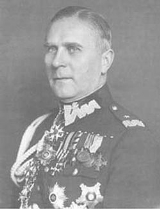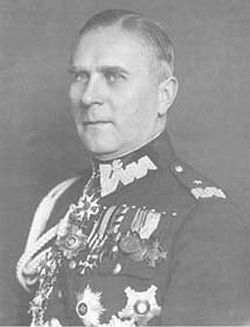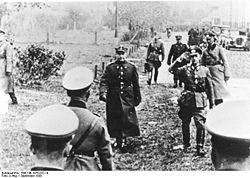
Tadeusz Kutrzeba
Encyclopedia


General
A general officer is an officer of high military rank, usually in the army, and in some nations, the air force. The term is widely used by many nations of the world, and when a country uses a different term, there is an equivalent title given....
of the Second Polish Republic
Second Polish Republic
The Second Polish Republic, Second Commonwealth of Poland or interwar Poland refers to Poland between the two world wars; a period in Polish history in which Poland was restored as an independent state. Officially known as the Republic of Poland or the Commonwealth of Poland , the Polish state was...
.
Kutrzeba was born in Kraków
Kraków
Kraków also Krakow, or Cracow , is the second largest and one of the oldest cities in Poland. Situated on the Vistula River in the Lesser Poland region, the city dates back to the 7th century. Kraków has traditionally been one of the leading centres of Polish academic, cultural, and artistic life...
, then part of Austria-Hungary
Austria-Hungary
Austria-Hungary , more formally known as the Kingdoms and Lands Represented in the Imperial Council and the Lands of the Holy Hungarian Crown of Saint Stephen, was a constitutional monarchic union between the crowns of the Austrian Empire and the Kingdom of Hungary in...
. In 1906 he graduated with distinction from the Military Technical Academy (Wojskowa Akademia Techniczna) in Mödling
Mödling
Mödling is the capital of the Austrian district of the same name located approximately 14 km south of Vienna.The settlement dates back to the Neolithic. In medieval times, the town was the residence of a branch of the Babenberger family, as a result of which it received the nickname...
and was enlisted as Second Lieutenant
Second Lieutenant
Second lieutenant is a junior commissioned officer military rank in many armed forces.- United Kingdom and Commonwealth :The rank second lieutenant was introduced throughout the British Army in 1871 to replace the rank of ensign , although it had long been used in the Royal Artillery, Royal...
in a minesweeping unit.
During the Invasion of Poland
Invasion of Poland (1939)
The Invasion of Poland, also known as the September Campaign or 1939 Defensive War in Poland and the Poland Campaign in Germany, was an invasion of Poland by Germany, the Soviet Union, and a small Slovak contingent that marked the start of World War II in Europe...
in 1939 he commanded the Poznań Army
Poznan Army
Army Poznań led by mj. gen. Tadeusz Kutrzeba was one of the Polish Armies during the Polish Defensive War in 1939.-Tasks:Flanked by Armia Pomorze to the north and Armia Łódź to the south, the Army was to provide flanking operations in Grand Poland region, defend it and withdraw towards lines of...
composed of four infantry divisions (14, 17, 25, 26) and two cavalry brigades (Wielkopolska and Podolska). He devised the Polish counterattack plan of the battle of Bzura and commanded the Poznan and Pomorze Armies during the battle. After the siege of Warsaw
Siege of Warsaw (1939)
The 1939 Battle of Warsaw was fought between the Polish Warsaw Army garrisoned and entrenched in the capital of Poland and the German Army...
he was captured by the Germans and spent the rest of the war in several prisoner of war
Prisoner of war
A prisoner of war or enemy prisoner of war is a person, whether civilian or combatant, who is held in custody by an enemy power during or immediately after an armed conflict...
camps: Hohenstein
Hohenstein
Hohenstein may refer to several different places in Germany, including* Hohenstein-Ernstthal, in Saxony* Sayn-Wittgenstein-Hohenstein, a county of the Holy Roman Empire , situated between Hesse-Darmstadt and Westphalia...
, Koenigstein and Oflag VII-A Murnau
Oflag VII-A Murnau
Oflag VII-A Murnau was a German Army POW camp for Polish Army officers and generals during World War II. It was located in the Bavarian town of Murnau am Staffelsee....
.
After World War II
World War II
World War II, or the Second World War , was a global conflict lasting from 1939 to 1945, involving most of the world's nations—including all of the great powers—eventually forming two opposing military alliances: the Allies and the Axis...
he became chairman of the September Campaign Historical Committee in London
London
London is the capital city of :England and the :United Kingdom, the largest metropolitan area in the United Kingdom, and the largest urban zone in the European Union by most measures. Located on the River Thames, London has been a major settlement for two millennia, its history going back to its...
. He was struck with cancer
Cancer
Cancer , known medically as a malignant neoplasm, is a large group of different diseases, all involving unregulated cell growth. In cancer, cells divide and grow uncontrollably, forming malignant tumors, and invade nearby parts of the body. The cancer may also spread to more distant parts of the...
and died in London on 8 January 1947.
Poland
- Commander's Cross of the Virtuti MilitariVirtuti MilitariThe Order Wojenny Virtuti Militari is Poland's highest military decoration for heroism and courage in the face of the enemy at war...
, previously awarded the Knight's Cross and the Silver Cross (1921) - Commander's Cross of the Order of Polonia Restituta (1930), previously awarded the Officer's Cross
- Cross of Valour - three times
- Gold Cross of Merit
Foreign
- Officer of the Legion of Honour (France)
- Commander's Cross of the Order of the Star of RomaniaOrder of the Star of RomaniaThe Order of the Star of Romania is Romania's highest civil order. It is awarded by the President of Romania...
- Commander's Cross of the Order of the Crown (Belgium)Order of the Crown (Belgium)The Order of the Crown is an Order of Belgium which was created on 15 October 1897 by King Leopold II in his capacity as ruler of the Congo Free State. The order was first intended to recognize heroic deeds and distinguished service achieved from service in the Congo Free State - many of which acts...
- Cross of Liberty, Class II (Estonia)
- Order of the Cross of the EagleOrder of the Cross of the EagleThe Order of the Cross of the Eagle was instituted in 1928 by the Estonian Defence League to commemorate the tenth anniversary of Estonian independence. It was adopted as a state order in 1936.The Order of the Cross of the Eagle is bestowed to give recognition for military services and services...
, Class II (1932, Estonia) - Order of LāčplēsisOrder of LacplesisThe Order of Lāčplēsis, the first and the highest Latvian military award, was established in 1919 on the initiative of the Commander of Latvian Army, during the Latvian War of Independence, Jānis Balodis. The Lāčplēsis Order is awarded in the first, second and third class. Initially, a holder of...
Third Class (Latvia) - Academic Golden Laurel of the Polish Academy of Literature

